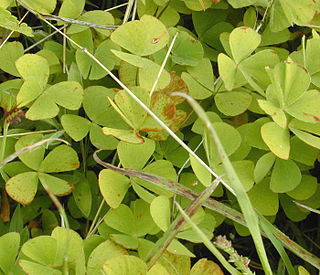
Schizaeales is an order of ferns.

Osmunda is a genus of primarily temperate-zone ferns of family Osmundaceae. Five to ten species have been listed for this genus.

Equisetales is an order of subclass Equisetidae with only one living family, Equisetaceae, containing the genus Equisetum (horsetails).

The order Salviniales is an order of ferns in the class Polypodiopsida.

The Dryopteridaceae are a family of leptosporangiate ferns in the order Polypodiales. They are known colloquially as the wood ferns. In the Pteridophyte Phylogeny Group classification of 2016 (PPG I), the family is placed in the suborder Polypodiineae. Alternatively, it may be treated as the subfamily Dryopteridoideae of a very broadly defined family Polypodiaceae sensu lato.

The order Cyatheales, which includes most tree ferns, is a taxonomic order of the fern class, Polypodiopsida. No clear morphological features characterize all of the Cyatheales, but DNA sequence data indicate the order is monophyletic. Some species in the Cyatheales have tree-like growth forms from a vertical rhizome, others have shorter or horizontal expanding rhizomes.

The order Polypodiales encompasses the major lineages of polypod ferns, which comprise more than 80% of today's fern species. They are found in many parts of the world including tropical, semitropical and temperate areas.

Blechnaceae is a family of ferns in the order Polypodiales, with a cosmopolitan distribution. Its status as a family and the number of genera included have both varied considerably. In the Pteridophyte Phylogeny Group classification of 2016, the family has 24 genera, and excludes genera placed in the separate family Onocleaceae. The family is divided into three subfamilies, including Blechnoideae s.s. Alternatively, the entire family may be treated as the subfamily Blechnoideae s.l. of a very broadly defined family Aspleniaceae, and include genera others place in Onocleaceae.

Pteridaceae is a family of ferns in the order Polypodiales, including some 1150 known species in ca 45 genera, divided over five subfamilies. The family includes four groups of genera that are sometimes recognized as separate families: the adiantoid, cheilanthoid, pteridoid, and hemionitidoid ferns. Relationships among these groups remain unclear, and although some recent genetic analyses of the Pteridales suggest that neither the family Pteridaceae nor the major groups within it are all monophyletic, as yet these analyses are insufficiently comprehensive and robust to provide good support for a revision of the order at the family level.

The Lomariopsidaceae is a family of ferns with a largely tropical distribution. In the Pteridophyte Phylogeny Group classification of 2016 (PPG I), the family is placed in the suborder Polypodiineae of the order Polypodiales. Alternatively, it may be treated as the subfamily Lomariopsidoideae of a very broadly defined family Polypodiaceae sensu lato.

Saccolomataceae is a family of ferns in the order Polypodiales with about 19 species. It has been formerly treated as part of the Dennstaedtiaceae, however it has been classified as its own family according to Smith et al. (2006) The genus Saccoloma has been classified to include Orthiopteris, but the phylogeny of the group not yet fully understood. The family includes a dozen known species.

Llavea is a monotypic genus of fern in the family Pteridaceae. The sole species is Llavea cordifolia. It is often cultivated as an ornamental foliage plant. The genus was named in honour of Pablo de La Llave, a Mexican naturalist.

Tectariaceae is a family of leptosporangiate ferns in the order Polypodiales. In the Pteridophyte Phylogeny Group classification of 2016 (PPG I), the family is placed in the suborder Polypodiineae. Alternatively, it may be treated as the subfamily Tectarioideae of a very broadly defined family Polypodiaceae sensu lato. The family comprises seven genera, of which Tectaria is by far the largest.

Polypodioideae is a subfamily belonging to the fern family Polypodiaceae, which is a member of the suborder Polypodiineae in the Pteridophyte Phylogeny Group classification of 2016 (PPG I). Alternatively, the subfamily may be treated as the tribe Polypodieae within a very broadly defined family Polypodiaceae sensu lato.

Grammitidoideae is a subfamily of the fern family Polypodiaceae, whose members are informally known as grammitids. It comprises a clade of about 750 species. They are distributed over higher elevations in both the Old and New World. This group was previously treated as a separate family, Grammitidaceae until molecular phylogenies showed it to be nested within the Polypodiaceae. It has since been treated as an unranked clade within subfamily Polypodioideae, and, most recently, as a separate subfamily.

Vittarioideae is a subfamily of the fern family Pteridaceae, in the order Polypodiales. The subfamily includes the previous families Adiantaceae and Vittariaceae.

Parkerioideae, synonym Ceratopteridoideae, is one of the five subfamilies in the fern family Pteridaceae. It includes only the two genera Acrostichum and Ceratopteris. The following diagram shows a likely phylogenic relationship between the two Parkerioideae genera and the other Pteridaceae subfamilies.

Pteridoideae is one of the five subfamilies of the fern family Pteridaceae. This subfamily contains about 14 genera and around 400 species.

Cheilanthoideae is one of the five subfamilies of the fern family Pteridaceae. The subfamily is thought to be monophyletic, but some of the genera into which it has been divided are not, and the taxonomic status of many of its genera and species remains uncertain, with radically different approaches in use as of December 2019.

Ophioglossidae is one of the four subclasses of Polypodiopsida (ferns). This subclass consists of the ferns commonly known as whisk ferns, grape ferns, adder's-tongues and moonworts. It is equivalent to the class Psilotopsida in previous treatments, including Smith et al. (2006). The subclass contains two orders, Psilotales and Ophioglossales, whose relationship was only confirmed by molecular phylogenetic studies.




















